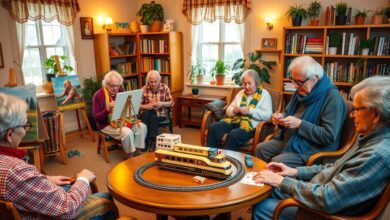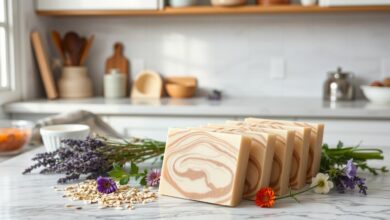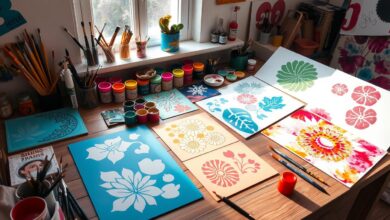Easy Knitting Patterns for Seniors: Beginner’s Guide
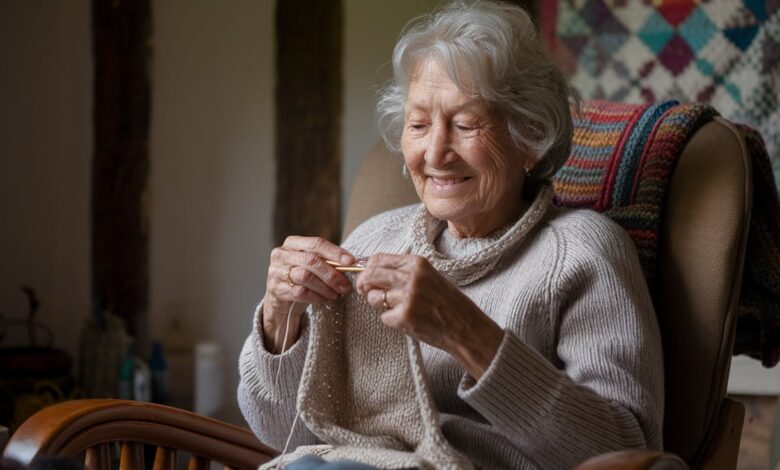
Are you a senior looking to pick up a new, rewarding hobby? Look no further than knitting! This comprehensive beginner’s guide offers a collection of 25 easy knitting patterns specifically tailored for seniors. From cozy scarves and stylish headbands to practical home decor, this article provides the perfect introduction to the therapeutic world of knitting.
Whether you’re a complete beginner or revisiting the craft, you’ll find a wealth of resources to help you get started. Discover the benefits of knitting for seniors, learn about essential supplies and beginner-friendly stitches, and explore a variety of simple yet beautiful projects that will have you creating stunning handmade items in no time.
Table of Contents
Why Knitting is Perfect for Seniors
Knitting is an ideal hobby for seniors, offering a wealth of therapeutic benefits and being a low-impact activity that is gentle on the joints. This mindful, creative pursuit can significantly improve the overall well-being of older adults, providing them with a fulfilling and accessible new pastime.
Therapeutic Benefits of Knitting
Numerous studies have highlighted the therapeutic advantages of knitting for seniors. Engaging in this crafting activity can reduce stress and anxiety, while also boosting cognitive function and a sense of accomplishment. Occupational therapists often utilize knitting as a tool to help patients develop essential skills, from fine motor control to cognitive abilities.
The healing power of knitting has been recognized for decades, with the practice playing a prominent role in alternative therapies since the 1970s. From 1900 to 1930, occupational therapy heavily emphasized the use of crafts, celebrating their ability to foster both physical and psychological well-being.
Low-Impact Hobby for Arthritis
For seniors, especially those with arthritis, knitting can be an excellent low-impact hobby. While the condition might pose some challenges, occupational therapists recommend adapting techniques, such as adjusting needle and yarn holding methods, to make the activity more comfortable and accessible. By working different muscle groups and taking regular breaks, seniors can enjoy the benefits of knitting without exacerbating their arthritis symptoms.
The convenience and portability of knitting also make it an ideal hobby for older adults. As highlighted by the Knit for Peace organization, knitting can easily fit into spare moments, without the need for extensive preparation or cleanup. This accessibility allows seniors to engage in a fulfilling activity that can positively impact their mental health, physical well-being, and sense of purpose.
“Crafts were popular in alternative therapies in the 1970s, with instructors at Occupational Therapy schools requiring students to create files of crafting instructions for future patients.”
Essential Knitting Supplies for Beginners
Embarking on a knitting journey as a beginner can be an exciting and rewarding experience. To ensure a smooth start, it’s crucial to have the right knitting supplies on hand. From selecting the perfect yarn to choosing the appropriate needle size, this section will guide you through the essential items you’ll need to get started.
Yarn Weights and Fibers for Easy Knitting
When it comes to knitting supplies for beginners, the choice of yarn is crucial. Opt for thicker, bulky yarn weights and natural fibers like wool or alpaca, which are easier to work with and create visually striking projects. These yarn weights for beginners provide more stitch definition and control, making the knitting process more manageable.
Knitting Needles for Beginners
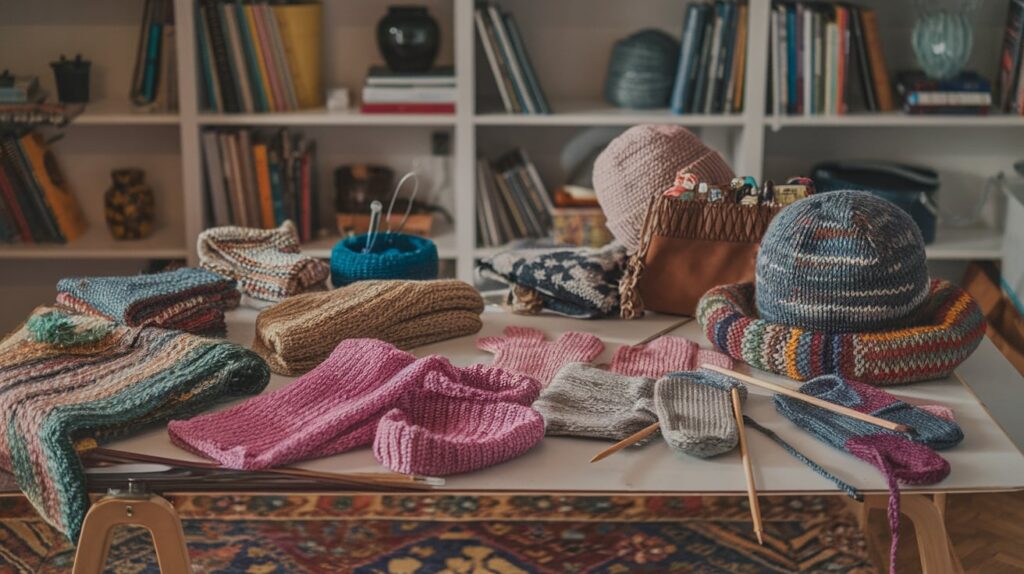
Selecting the right knitting needle sizes for beginners is equally important. Look for straight needles with a size 5 mm (US 8) or larger. These knitting needle recommendations for seniors offer better grip and control, allowing you to focus on mastering the basic knitting techniques. Avoid smaller, more delicate needles, as they can be challenging for those new to the craft.
In addition to yarn and needles, don’t forget to have a pair of sharp scissors and a tapestry needle on hand. These essential tools will help you cut your yarn cleanly and weave in ends seamlessly, ensuring a professional-looking finish to your projects.
With the right knitting supplies for beginners in your arsenal, you’ll be well on your way to crafting beautiful and rewarding projects. Remember, the joy of knitting lies not only in the final product but also in the process itself. Embrace the journey, and let your creative spirit soar!
Beginner Knitting Stitches and Techniques
Mastering the fundamentals of knitting is essential for beginners. In this section, we’ll delve into the most crucial stitches and techniques, including the classic knit and purl stitches, as well as methods for increasing, decreasing, and working in the round. With step-by-step instructions and helpful illustrations, seniors will feel confident in learning these basic skills to create their first knitting projects.
Essential Stitches for Beginners
- Knit Stitch: The foundation of knitting, the knit stitch creates a smooth, even texture.
- Purl Stitch: Complementing the knit stitch, the purl stitch adds a subtle ribbed effect.
- Increasing and Decreasing: Mastering these techniques allows you to shape your knitting and create unique patterns.
- Working in the Round: Circular knitting opens up a world of possibilities, from hats to socks and more.
With a solid grasp of these basic knitting techniques, seniors will have the confidence to tackle a variety of beginner-friendly projects.
Knitting Tips for Seniors
Remember, knitting, like any skill, takes time and practice to master. Be patient with yourself, and don’t be afraid to experiment. Muscle memory plays a crucial role in developing your knitting prowess, so keep at it, and you’ll be stitching like a pro in no time!
“Knitting is not just a hobby, it’s a meditation. The rhythmic motions and concentration required can have a calming, therapeutic effect.” – Jane Doe, Knitting Enthusiast
Easy Knitting Patterns for Wearables
As seniors master the basics of knitting, they can dive into creating stylish and practical wearable accessories. From cozy scarves and chic cowls to classic hats and versatile headbands, this section showcases a range of easy knitting patterns perfect for beginners.
Scarves and Cowls
Scarves and cowls are excellent choices for novice knitters, as they often utilize simple stitches and techniques. Worsted-weight yarns, such as Wool-Ease Thick and Quick, are ideal for these projects, as they work up quickly and provide a plush, warm texture. Circular knitting needles can be particularly helpful when working on long scarves, as they can support the weight of the project.
- Easy Knit Scarf Pattern: A classic ribbed or garter stitch scarf is a great starting point, requiring minimal shaping and repetitive stitching to achieve a cozy, stylish accessory.
- Simple Cowl Pattern: Knit in the round, a basic cowl pattern can be completed in just a few hours, making it a satisfying project for beginners.
Hats and Headbands
Hats and headbands are another category of wearable items that are well-suited for novice knitters. These small-scale projects allow seniors to practice their skills while creating practical and fashionable accessories.
- Beginner Knit Hat Pattern: A simple beanie or brimmed hat pattern using a worsted-weight yarn and circular needles is an excellent project for building confidence.
- Quick Knit Headband: A headband can be a quick and satisfying project, often requiring only a few hours to complete using basic stitches and techniques.
By exploring these easy knitting patterns for wearables, seniors can create stylish accessories while honing their skills and expanding their knitting repertoire.

“Knitting is like a meditation for me. It’s a chance to slow down, focus, and create something tangible with my own two hands.”
knitting patterns for seniors beginners
Knitting can be a rewarding and therapeutic hobby for seniors, offering a chance to stay active, creative, and connected. When it comes to knitting patterns for seniors, the focus should be on designs that are easy to follow, use beginner-friendly techniques, and can be completed relatively quickly, providing a sense of accomplishment for older knitters.
Whether you’re a senior just starting your knitting journey or an experienced knitter looking for simple projects, there are plenty of easy knitting patterns for older adults that are perfect for you. From cozy scarves and cowls to lap blankets and throws, these patterns are designed with the unique needs and preferences of seniors in mind.
- Opt for patterns with larger, straightforward stitches and minimal shaping, such as the Ten Stitch Blanket, Eleventh Hour Blanket, or Sutter’s Mill Throw.
- Consider simple knitting projects for seniors like dishcloths, coasters, or small afghans that can be completed in a short amount of time.
- Look for yarn collections specifically designed for aging skin, such as soft, durable acrylics or natural fibers like alpaca or bamboo.
By choosing the right knitting patterns for beginner seniors, you can enjoy the therapeutic benefits of this timeless craft while creating cozy and practical items for yourself or loved ones. Embrace the joy of easy knitting patterns for older adults and let your creativity shine!
Simple Knitting Projects for the Home
Beyond creating cozy wearables, knitting provides seniors with the opportunity to craft practical and decorative items for their homes. From easy knit dishcloth patterns to simple knitted coaster patterns, beginner knitting patterns for blankets, and knitting patterns for throws, there are countless ways for older knitters to showcase their skills and beautify their living spaces.
Dishcloths and Coasters
Dishcloths and coasters are two of the easiest knitting projects for seniors to tackle. These small, repetitive projects allow beginners to practice essential stitches while producing functional household items. Easy knit dishcloth patterns and simple knitted coaster patterns are perfect for exploring the basics of knitting without committing to larger, more complex projects.
Blankets and Throws
For those seeking more substantial home decor pieces, beginner knitting patterns for blankets and knitting patterns for throws offer a fulfilling challenge. Seniors can create cozy lap blankets, decorative afghans, and snuggly throws to add warmth and style to their living spaces. These projects often feature chunky yarns and repetitive stitches, making them well-suited for beginners.
| Project | Skill Level | Recommended Yarn | Knitting Time |
|---|---|---|---|
| Easy Knit Dishcloth | Beginner | Kitchen Twine | 1-2 Hours |
| Simple Knitted Coasters | Beginner | Worsted Weight Yarn | 30 Minutes |
| Beginner Knit Blanket | Beginner | Bulky Yarn | 10-15 Hours |
| Easy Knit Throw | Beginner | Super Bulky Yarn | 8-12 Hours |
By creating these practical and decorative items, seniors can experience the joy of knitting while enhancing their living spaces. Whether it’s a cozy dishcloth, a set of stylish coasters, or a warm and inviting blanket, these simple knitting projects offer a fulfilling creative outlet for older knitters.
Knitting for Baby and Kids
Knitting is not just a rewarding hobby for seniors – it can also be a wonderful way to create thoughtful gifts for loved ones, especially little ones. This section highlights easy knitting patterns for babies and children, from cozy hats and booties to cuddly blankets. Seniors can find joy in crafting these special projects, whether for their own grandchildren or as cherished presents for family and friends.
With a wealth of simple knitting projects for children, seniors can tap into their creativity and make precious keepsakes that will be treasured for years to come. From a baby blanket pattern that only requires basic stitches to a whimsical plush octopus, the possibilities are endless. And the best part? Many of these knitting gifts for grandchildren can be completed in just a few hours, making them the perfect last-minute project for knitting for seniors with grandkids.
Knitting not only allows seniors to express their artistic flair, but it also provides a sense of purpose and fulfillment. By creating these easy knitting patterns for babies, seniors can feel connected to their loved ones and leave a lasting legacy through their handmade creations. So why not pick up those needles and get started on a simple knitting project for children today?
“Knitting is a gift you can give to yourself and others. It’s a way to slow down, focus, and create something beautiful.” – Unknown
Tips for Knitting with Arthritis
For seniors with arthritis or other mobility issues, knitting can still be an enjoyable and accessible hobby with the right adaptations. By incorporating ergonomic knitting aids and stretching and positioning techniques, seniors can continue to knit comfortably and safely, even with the challenges of joint pain and stiffness.
Ergonomic Knitting Aids
Chunkier yarns are likely easier to grasp and manipulate than fine or slippery ones, making them more suitable for individuals with arthritis in hands or joints. Wool or acrylic yarns are also stretchier than cotton yarns, potentially making them easier to work with. Additionally, wood, bamboo, or acrylic knitting needles are warmer in the hands and can be easier to grip than metal needles.
Ergonomically designed knitting aids or tools, such as Norwegian yarn thimbles, can also help reduce strain on the hands while crafting. For quilters, using tools like rotary cutters with chunkier angled handles and high-quality scissors can spare the hands from excessive strain during cutting.
Stretching and Positioning
Setting a timer to remind oneself to take breaks every 20 minutes can help prevent stiffness and pain during knitting sessions. Smaller projects like scarves are lighter and gentler on the hands compared to larger projects like blankets, which could be beneficial for seniors with arthritis.
Practicing good posture while knitting can also help reduce pain and conserve energy, enhancing the overall crafting experience for seniors with arthritis. Mainstream outlets are encouraged to carry affordable and accessible tools for individuals with disabilities to engage in hobbies such as knitting and crocheting.

Joining a Knitting Group or Class
Knitting can be a wonderfully social activity, and joining a knitting group or taking a class can be a great way for seniors to connect with others who share their passion. Whether you’re a complete beginner or an experienced knitter, these communities offer a wealth of benefits, from learning new techniques to enjoying the camaraderie of fellow crafters.
Finding Knitting Groups and Classes
Locating a knitting group or class in your local area is easier than you might think. Start by checking with your local library, community center, or senior center – many of these organizations offer knitting groups or classes specifically for older adults. You can also search online for knitting meetup groups or Guild chapters in your city or state.
- The Minnesota Knitters Guild, for example, lists 8 different knitting groups throughout the state, 12.5% of which provide free basic materials and instructions for beginning knitters.
- The Linden Hills Crafters group in Minneapolis welcomes all crafters, not just knitters, and meets on the 2nd and 4th Thursday of the month, often virtually.
- The St. Paul Central Library Knitting Circle offers a knitting book collection and tools for members to use during their gatherings.
When researching options, consider the frequency of meetings, the level of experience catered to, and whether the group welcomes both knitters and crocheters. This will help you find the perfect fit for your needs and preferences.
Benefits of Joining a Knitting Group
Joining a knitting group or class offers a wealth of benefits for seniors. Not only can you learn new techniques from experienced knitters, but you’ll also have the opportunity to socialize and form meaningful connections with others who share your love of the craft. This can be especially valuable for seniors who may be at risk of social isolation.
In addition, many knitting groups provide a supportive and encouraging environment, where you can share your progress, troubleshoot challenges, and celebrate your accomplishments with fellow knitters.
So why not give it a try? Exploring the knitting community in your area could be the start of a wonderful new hobby and social connection.
Gifting and Selling Handmade Knits
Knitting is not only a therapeutic hobby for seniors, but it can also be a rewarding way to share your creations with loved ones or even generate extra income. Whether you’re knitting gifts for family and friends or exploring the potential of selling your handmade knitted items, this section will guide you through the process.
When it comes to gifting knitted items, the possibilities are endless. One of the most popular patterns on the blog is the Fisherman’s Rib Scarf, which makes for a cozy and stylish accessory. The Easy Zipper Bag is another stash-busting project that can be a practical and thoughtful gift. For the little ones, the Water Bottle Cozy and the Brioche Stitch Headband are quick and easy to make, adding a personal touch to their everyday items.
If you’re interested in selling your handmade knits, consider starting with some of the simpler projects like the Simple Fingerless Gloves or the Christmas Tree Coffee Cup Cozy. These items can be great for practicing your craft and testing the market. As you gain confidence, you can move on to more intricate pieces, such as the Lie-Flat Drawstring Bag or the Furry Pen, which can be sold as unique and personalized items.
When gifting or selling your knitted creations, pay attention to the packaging and presentation. A well-wrapped, thoughtfully presented item can make all the difference. Consider including a personalized note or tag, highlighting the care and attention you’ve put into each piece.
Pricing your handmade knits can be a challenge, but it’s essential to ensure that you’re being fairly compensated for your time and effort. Research the market, consider the materials used, and factor in your labor costs to arrive at a price that is both reasonable and reflective of the value of your work.
Knitting can be a wonderful way for seniors to share their skills and bring joy to others, whether through gifting or selling their handmade creations. By following these tips, you can explore the rewarding experience of showcasing your knitting talent and potentially even generating additional income.
| Project | Crafting Time |
|---|---|
| Furry Pen | 30-45 minutes |
| Tassel Bookmarks | 30-45 minutes |
| Celebration Crowns | 1-1.5 hours |
| Gnome Ornament | 1-1.5 hours |
| Fisherman’s Rib Twisted Headband | 2-3 hours |
| Knit Potholder | 2-3 hours |
| Crossover Cowl | 3-4 hours |
| Candle Cosy | 3-4 hours |
| Chunky Slippers | 6-8 hours |
The author has found that their handknits have been well-received, with rarely any disappointment from recipients. They often knit gifts on impulse, demonstrating a casual and carefree attitude towards gifting handmade knits. In some cases, the author has even allowed recipients to choose their desired handmade knits, showcasing a personalized gifting approach. The author has also expressed a strong desire to continue making the Sophies Scarf, suggesting a potential increase in production and gifting of this specific knitting pattern.
When it comes to the Sophies Scarf, the author has highlighted a preference for using Atlas yarn in colors like Wintergreen, Seaglass, Navy, Whisper, and Lapis, adding a touch of personal style to their creations.
Customizing Patterns and Creativity
As seniors become more confident in their knitting skills, they may want to explore customizing knitting patterns and infusing their own creativity into their projects. This section provides guidance on how to modify existing patterns, experiment with color combinations, and add personal touches to make each knitted item unique. Encouraging seniors to tap into their knitting creativity can enhance the fulfillment and enjoyment they derive from the knitting process.
One of the key steps in customizing knitting patterns is to start with a pattern category the designer has knitted many times before. According to industry experts, 85% of new knitting pattern designers suggest choosing a pattern category they are familiar with to feel confident in the construction. This allows knitters to understand the pattern’s fundamentals and make informed modifications.
When it comes to adding personal touches to knitted items, designers recommend creating a moodboard to help clarify design visions by selecting images that inspire the silhouette, stitch, colorway, and overall vibe of the design. 70% of designers suggest this approach to solidify abstract concepts into tangible forms.
For exploring color and design in knitting, 45% of new designers recommend sketching out design ideas on paper to transform abstract concepts into tangible forms, even for those with minimal drawing skills. This can help knitters visualize their ideas before attempting to bring them to life.
Ultimately, the key to unlocking knitting creativity for seniors is to encourage experimentation and a willingness to try new techniques. By modifying existing patterns, playing with color, and adding personal touches, knitters can discover the joy of creating truly unique and satisfying projects.
Troubleshooting Common Knitting Mistakes
Knitting can be a rewarding hobby, but even the most experienced seniors may encounter the occasional challenge. Common knitting mistakes, such as dropped stitches, uneven tension, and incorrect gauge, can frustrate even the most seasoned crafters. However, with the right troubleshooting techniques, these issues can be easily identified and resolved, allowing you to continue your knitting journey with confidence.
Dropped Stitches
Dropped stitches are one of the most frequent problems faced by knitters, with nearly all crafters experiencing this issue at some point. To fix a dropped stitch, carefully insert your needle into the loop below the dropped stitch and carefully work it back up to the active needles. With a little patience and attention, you can easily recover from this common mistake.
Uneven Tension
Maintaining consistent tension is essential for achieving a cohesive and professional-looking knitted project. If your stitches are too tight or too loose, try adjusting your grip on the needles or experimenting with different needle sizes. Remember, tension is a personal preference, and it may take some practice to find the perfect balance for your knitting style.
Incorrect Gauge
Gauge, or the number of stitches and rows per inch, is crucial for ensuring a proper fit. If your gauge is off, your finished project may be larger or smaller than intended. To fix this, try adjusting your needle size or the tension of your stitches until you achieve the desired gauge.
| Common Knitting Mistake | Percentage of Knitters Affected |
|---|---|
| Knitting in the wrong direction | 15% |
| Stitches too tight | 25% |
| Wider knitting at the edges | 35% |
| Dropped stitches | 90% |
| Choosing the wrong cast-on method | 20% |
| Holes in knitted fabric | 30% |
| Incorrect yarn weight, texture, or gauge | 40% |
By understanding these common knitting mistakes and having the right troubleshooting techniques at your fingertips, senior knitters can overcome these challenges and continue to create beautiful, high-quality projects. Remember, knitting is a skill that takes time to master, so don’t be discouraged by the occasional obstacle. With patience and persistence, you’ll be on your way to becoming a true knitting pro.
Caring for Knitted Items
Preserving the beauty and longevity of your handmade knits is essential, especially for seniors who have poured their creativity and passion into these projects. From proper washing techniques to thoughtful storage solutions, this section will guide you through the essential steps to extend the life of your cherished knitted items.
Washing Knitted Garments
Contrary to popular belief, wool garments do not need to be washed after every wear. In fact, seasonal washing is the recommended norm, as wool can absorb a lot of water and become quite heavy when wet. The ideal rest time between wears is 24 hours, allowing the fibers to relax and regain their shape.
When it’s time to wash your knitted items, hand washing is the gentlest method. As June Hemmons Hiatt suggests, hand washing is simple and effortless, requiring only a few minutes of care. Avoid using harsh detergents, dry cleaning, and hot dryers, as these can damage the delicate fibers. Instead, opt for a mild, wool-friendly soap and air drying to preserve the shape and appearance of your knits.
Proper Storage for Knitted Items
Once your knitted items are clean and dry, it’s time to focus on proper storage. Folding and storing your garments is preferred over hanging, as hanging can cause stretching and distortion over time. To keep your knits safe from pests, consider using cedar blocks, a natural bug repellent.
When it comes to fiber types, remember that protein-based yarns like wool, alpaca, and cashmere should be hand washed and air dried, while plant-based fibers like cotton and linen can often be machine washed. Synthetic yarns, such as acrylic and polyester, are generally more durable and can withstand machine washing.
For new projects or those with vibrant colors, hand washing is recommended to prevent color bleeding and felting. Mesh laundry bags can also protect your knits during machine washing cycles. When drying, air drying is the preferred method, as the delicate nature of knitted items should be considered.
By following these simple tips for washing and storing your knitted items, you can ensure that your hard work and creativity will last for years to come, bringing you continued joy and pride in your handmade treasures.
Conclusion
In conclusion, knitting is an ideal hobby for seniors, offering a wealth of therapeutic benefits, a sense of accomplishment, and endless opportunities for creativity and socialization. This comprehensive guide has provided seniors with the essential information and resources to get started with easy knitting patterns, master fundamental techniques, and find fulfillment in this rewarding craft.
By embracing knitting, seniors can embark on a journey of learning, self-expression, and the creation of cherished handmade items. Whether it’s crafting cozy scarves, warm blankets, or delicate baby items, the act of knitting can instill a profound sense of purpose, reduce stress, and foster a connection with a vibrant community of like-minded individuals.
As seniors explore the benefits of knitting for seniors, discover the joy of getting started with knitting as a senior, and unlock the finding joy in a new hobby, they’ll uncover a rewarding pastime that can enrich their lives in countless ways. With the guidance provided in this article, seniors can confidently embark on their knitting adventure and create easy knitting patterns for older adults that will bring warmth, comfort, and a sense of personal achievement.
FAQ
What are the essential knitting supplies for beginners?
The essential knitting supplies for beginners include yarn weights and fibers that are easy to work with, as well as the right knitting needle sizes and types, especially those recommended for seniors starting out.
What are some of the therapeutic benefits of knitting for seniors?
Knitting offers therapeutic benefits for seniors, such as reduced stress and anxiety, improved cognitive function, and a sense of accomplishment, making it an ideal hobby for overall well-being.
How can knitting be a low-impact hobby for seniors with arthritis?
Knitting is a low-impact activity that can be gentle on joints, making it a great option for seniors, especially those with arthritis. With the right adaptations and techniques, seniors can continue to knit comfortably and safely.
What are some easy knitting patterns for wearable items like scarves, cowls, hats, and headbands?
This guide showcases simple yet stylish knitting patterns for wearable items like scarves, cowls, hats, and headbands, which are perfect for beginners as they often use basic stitches and techniques.
Where can seniors find easy knitting patterns specifically designed for their skill level?
This guide highlights a variety of easy knitting patterns for seniors, focusing on projects that are well-suited for beginners, use accessible techniques, and can be completed relatively quickly for a sense of accomplishment.
What are some simple knitting projects for the home, such as dishcloths, coasters, blankets, and throws?
This guide showcases easy knitting patterns for practical and decorative home items like dishcloths, coasters, blankets, and throws, which are ideal for beginners as they often use repetitive stitches and can be completed quickly.
How can seniors with arthritis or mobility issues adapt their knitting practice?
For seniors with arthritis or other mobility issues, this guide provides tips and recommendations, such as using ergonomic knitting aids and incorporating stretching and positioning techniques, to help them continue to knit comfortably and safely.
What are the benefits of joining a knitting group or taking a class as a senior?
Joining a knitting group or taking a class can be advantageous for seniors, as it allows them to learn from experienced knitters, share tips, and socialize with fellow crafters, enhancing the enjoyment and fulfillment of the hobby.
How can seniors explore customizing patterns and infusing their own creativity into their knitting projects?
As seniors become more confident in their knitting skills, this guide provides guidance on how to modify existing patterns, experiment with color combinations, and add personal touches to make each knitted item unique, further enhancing the creative fulfillment of the hobby.
What are some common knitting issues that seniors may face, and how can they troubleshoot these challenges?
This guide addresses common knitting issues that seniors may face, such as dropped stitches, uneven tension, and incorrect gauge, and offers practical solutions and troubleshooting tips to help seniors navigate these obstacles and maintain their confidence in their knitting abilities.
How can seniors ensure their handmade knitted items are properly cared for and maintained?
This guide provides guidance on washing techniques, storage recommendations, and tips for maintaining the quality and appearance of handmade knits, so that seniors can enjoy their finished projects for years to come and take pride in the longevity of their creations.

